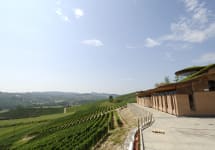Renato Ratti Rocche dell'Annunziata Barolo 2017
-
James
Suckling -
Wine
Enthusiast -
Robert
Parker -
Wine
Spectator



Product Details
Your Rating
Somm Note
Winemaker Notes
Garnet red. A delicate and persistent bouquet with traces of licorice, rose and tobacco. Full flavored, warm and moderately tannic.
Professional Ratings
-
James Suckling
Such subtlety and refinement to this young Barolo with dried strawberries, fine tannins and a citrus undertone. Medium body. Extremely dusty and polished. Clean finish. Drinkable now, but better after 2023.
-
Wine Enthusiast
Aromas of pressed rose, sandalwood, menthol and black-skinned berry mingle together in the glass along with a whiff of oak-driven spice. Fullbodied and loaded with finesse, the poised, savory palate delivers raspberry compote, strawberry and licorice before finishing on a coffee bean note. Taut, fine-grained tannins provide support. Drink 2025– 2032.
-
Robert Parker's Wine Advocate
From a historic vineyard site in La Morra, the Renato Ratti 2017 Barolo Rocche dell'Annunziata shows nicely balanced results in this vintage and is my favorite of this three Barolo release. The wine is redolent of dried cherry, cassis, crushed rose and dusty earth. To the palate, it is very fine and almost fragile, although the tannins are dry and loosely textured. We see this in Ratti's Barolos from Conca and Marcenasco as well.
-
Wine Spectator
A fragrant version, revealing rose, cherry and strawberry flavors, picking up notes of mint, iron and tobacco as this builds on the palate. There's a silkiness to the texture, yet with ample structure and a fresh finish.
Other Vintages
2019-
Wine
Enthusiast -
James
Suckling -
Jeb
Dunnuck -
Wine
Spectator
-
Wine
Enthusiast -
Robert
Parker - Decanter
-
James
Suckling -
Wine
Spectator
-
James
Suckling -
Wine
Spectator
-
Robert
Parker -
James
Suckling -
Wine
Spectator -
Wine
Enthusiast - Decanter
-
Wine
Enthusiast -
James
Suckling -
Robert
Parker
-
Robert
Parker -
Wine
Enthusiast -
James
Suckling -
Wine
Spectator
-
Wine
Enthusiast -
Wine
Spectator -
Robert
Parker
-
Wine
Spectator - Decanter
-
James
Suckling -
Robert
Parker
-
Wine
Enthusiast -
Robert
Parker -
James
Suckling
-
Robert
Parker -
Wine
Spectator
-
Wine
Spectator -
Wine
Enthusiast -
Robert
Parker
-
Wine
Spectator -
Robert
Parker
-
Wine
Spectator
-
Wine
Enthusiast -
Wine
Spectator








Located halfway up the hill dominating the principal valley of Barolo, buttressed by steep slopes lined by orderly vineyards, lies a precious jewel from the 15th century: the Abbey of Annunziata.
As the monks historically produced wine from the grapes of the surrounding hillsides, today, remembering their lessons, incomparable wines are produced.
From the 100 acres of vineyards, the Renato Ratti winery produces around 150,000 bottles from the traditional denominations of the area: Barolo, Nebbiolo d'Alba, Barbera d'Alba, Dolcetto d'Alba.
The modern and innovative philosophy of vinification introduced since the 60's by Renato Ratti, is today in the hands of his son Pietro and his nephew Massimo Martinelli.

Responsible for some of the most elegant and age-worthy wines in the world, Nebbiolo, named for the ubiquitous autumnal fog (called nebbia in Italian), is the star variety of northern Italy’s Piedmont region. Grown throughout the area, as well as in the neighboring Valle d’Aosta and Valtellina, it reaches its highest potential in the Piedmontese villages of Barolo, Barbaresco and Roero. Outside of Italy, growers are still very much in the experimentation stage but some success has been achieved in parts of California. Somm Secret—If you’re new to Nebbiolo, start with a charming, wallet-friendly, early-drinking Langhe Nebbiolo or Nebbiolo d'Alba.

The center of the production of the world’s most exclusive and age-worthy red wines made from Nebbiolo, the Barolo wine region includes five core townships: La Morra, Monforte d’Alba, Serralunga d’Alba, Castiglione Falletto and the Barolo village itself, as well as a few outlying villages. The landscape of Barolo, characterized by prominent and castle-topped hills, is full of history and romance centered on the Nebbiolo grape. Its wines, with the signature “tar and roses” aromas, have a deceptively light garnet color but full presence on the palate and plenty of tannins and acidity. In a well-made Barolo wine, one can expect to find complexity and good evolution with notes of, for example, strawberry, cherry, plum, leather, truffle, anise, fresh and dried herbs, tobacco and violets.
There are two predominant soil types here, which distinguish Barolo from the lesser surrounding areas. Compact and fertile Tortonian sandy marls define the vineyards farthest west and at higher elevations. Typically the Barolo wines coming from this side, from La Morra and Barolo, can be approachable relatively early on in their evolution and represent the “feminine” side of Barolo, often closer in style to Barbaresco with elegant perfume and fresh fruit.
On the eastern side of the Barolo wine region, Helvetian soils of compressed sandstone and chalks are less fertile, producing wines with intense body, power and structured tannins. This more “masculine” style comes from Monforte d’Alba and Serralunga d’Alba. The township of Castiglione Falletto covers a spine with both soil types.
The best Barolo wines need 10-15 years before they are ready to drink, and can further age for several decades.
